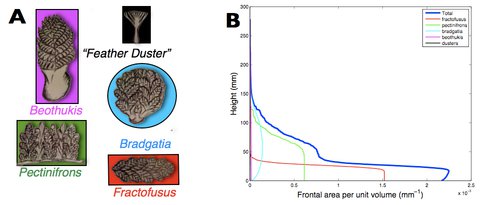2010 Annual Science Report
 Massachusetts Institute of Technology
Reporting | SEP 2009 – AUG 2010
Massachusetts Institute of Technology
Reporting | SEP 2009 – AUG 2010
Biomechanics of the Rangeomorph Fauna
Project Summary
Some of the oldest, multicellular organisms in the fossil record are enigmatic creatures called rangeomorphs. Although there is much debate as to whether the rangeomorphs are animals, fungi, or something completely unique, recent studies of the fossils suggest that the rangeomorphs used high surface areas to capture dissolved organic matter (DOM) as an energy source. In this project, we attempt to model how nutrients would have flowed over these deep-water organisms, to see how their large size might have helped them compete with bacteria for DOM. Our work suggests that competition with bacteria was a driving force in the evolution of the first complex organisms.
Project Progress
The project considers the nature of flow, redox conditions, and morphology based on the rangeomorph fossil communities recorded in the Ediacaran age rocks of Newfoundland. These rangeomorphs represent the early dawn of the evolution of complex multicellular life, preceding the rapid radiation of animals in the Cambrian.
The central puzzle revolves around the adaptive advantage of complex multicellular structures at this time. Why and under what conditions do these complex organisms, presumed to feed on dissolved material, have an advantage over bacteria that do the same?
It is known that oceanography and ocean geochemistry were distinctive. At the relevant (@1000m) depths water temperatures are inferred to be, cold, oxygenated, with no sulfate and significant dissolved organic matter (DOM). This suggests that these multicellular forms derived energy through direct, or symbiotic, oxidation of these reduced compounds.
We have proposed two models by which larger structures embedded in low flows might gain advantage over bacteria. The first hypothesis is that reduced compounds derived from the bottom might form a redox gradient sufficiently off the sea floor such that larger organisms could take advantage of it. The second hypothesis is that shear around objects sticking out into flow facilitates delivery of dissolved material across a diffusional boundary that limits bacterial growth.
Recent advances in modeling flow over complex substrates have improved our understanding of how boundary layers develop in this context. Marco Ghisalberti from the University of Western Australia has developed and applied a number of these “canopy” models, and has joined our team to reconstruct flow and mixing in the boundary layer.
Our preliminary work has already yielded exiting results. We have discovered quantitative support for the hypothesis that rangeomorphs evolved community-level tiering, yielding distinct hydrodynamic environments for different morphospecies [see figure 1]. We plan to modify the models to describe the fluxes of redox compounds in these communities, so that we may distinguish between the two hypotheses listed above. David Gold has presented this research at the Southern California Geobiology Symposium, the Astrobiology Science Convention, and the Annual NAI/MIT Meeting. Ultimately, this work should help clarify the adaptive advantage behind the evolution of some of earth’s earliest communities of large, complex organisms.
 Figure 1: Modeling flow in the rangeomorphs of the Shingle Head formation. [A] Images of the different morphospecies included in this study, and the shapes that were used to approximate each species in the modeling. [B] Flow regimes as a function of frontal area to height. This chart suggests that the different morphospecies fall into two or three distinct canopies that are subject to different flow regimes.
Figure 1: Modeling flow in the rangeomorphs of the Shingle Head formation. [A] Images of the different morphospecies included in this study, and the shapes that were used to approximate each species in the modeling. [B] Flow regimes as a function of frontal area to height. This chart suggests that the different morphospecies fall into two or three distinct canopies that are subject to different flow regimes.
Publications
- Gold, D.A., Laflamme, M., Johnston, D.T., Summons, R.E. & Jacobs, D.K. (2010). Constraints on the Evolution of the Ediacara with Special Consideration of the Mistaken Point Rangeomorph Fauna. Astrobiology Science Conference 2010: Evolution and Life: Surviving Catastrophes and Extremes on Earth and Beyond. League City, Texas.
-
PROJECT INVESTIGATORS:
-
PROJECT MEMBERS:
David Johnston
Collaborator
Roger Summons
Collaborator
-
RELATED OBJECTIVES:
Objective 4.2
Production of complex life.
Objective 5.2
Co-evolution of microbial communities
Objective 6.1
Effects of environmental changes on microbial ecosystems



